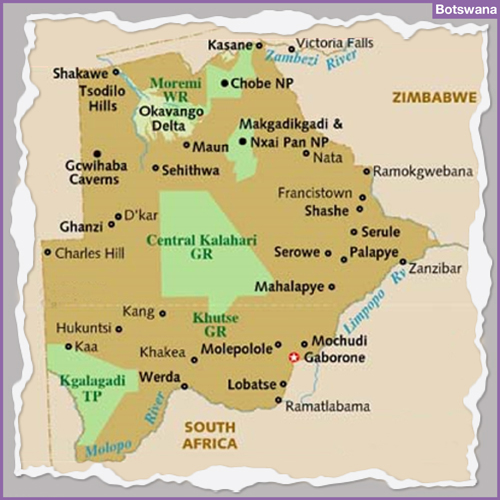BOTSWANA , SOUTHERN AFRICA

Botswana is an unspoiled land of timeless beauty – striking salt pans, diamond-rich deserts, fertile flood plains, vast grasslands, and flatlands punctuated with dramatic rocky outcrops. The country’s natural appeal lies in the stunning and seemingly endless wilderness, prolific wildlife, cultural diversity, and welcoming people. Defined by the Kalahari Desert, and its central Game Reserve with fossilized river valleys and undulating grasslands, and the Okavango Delta that becomes a lush animal habitat during the seasonal floods. Visitors will be charmed by the warmth of the people and experiencing their customs and centuries old traditions.
Topography & Climate
Botswana is a landlocked country in Southern Africa that is predominantly flat, tending toward gently rolling plateaux especially along the south eastern boundary and in the far northwest. The country is dominated by the Kalahari Desert that covers around 80% of its land surface. In the north eastern region of the Kalahari Basin is the Makgadikgadi Pans, anetwork of salt pans and ephemeral lakes; in the northwest is one of the world’s largest inland deltas,the Okavango Delta, a 15,000 sq. km network of water channels, lagoons, swamps and islands full of amazing wildlife.
Holidays and tours featured at this destination
General Information
Luxury accommodations in Botswana we currently recommend are the Belmond properties:
Eagle Camp Island | Khwai River Lodge | Savute Elephant Lodge
Kasne,situated on the banks of the Chobe River is an important point of debarkation for the nearby Victoria Falls in Zimbabwe and Livingstone in Zambia, and Namibia’s Caprivi Strip. Is the administrative centre of Chobe District with small shopping malls, arts and crafts shops. Behind the Kasane police station is the immense baobab tree, with a hollow big enough for humans to enter and was once used as a prison by colonial administrators. The main gateway into the Chobe National Park close to the Chobe River’s confluence with the Zambezi where the four countries of Botswana, Zambia, Zimbabwe, and Namibia meet. At Kazungula, about 10 kilometres away, there is a ferry crossing between Botswana and Zambia, and the Kazungula Snake Park which holds about 50 snakes, 17 different species, which includes the harmless Brown House Snake to the deadly Boomslang and Black Mamba. The park is run as a community-based project providing educational programmes for Batswana children by Caracal, the NGO, it is also a training programme to involve Batswana in the tourism industry.
The Okavango Delta, a UNESCO World Heritage Site in northern Botswana, it’s a vast, swampy inland river delta with sprawling grassy plains that seasonallyflood. A permanent and seasonal home to a wide variety of wildlife with large herds of elephant and buffalo, it’s become a major tourist attraction. Its estimated that over 200,000 large mammals can be in the delta at any one time, they include: hippopotamus, giraffe, crocodile, lion, cheetah, leopard, brown &spotted hyena, springbok, greater kudu, sable antelope, impala,black & white rhinoceros, zebra, warthog, baboon, the vervet monkeyand the endangeredCape wild dog. The delta is also home to over 400 species of birds, including African fish eagle, Pel’s fishing owl, crested crane, lilac-breasted roller, hammerkop, ostrich, and sacred ibis. In the Moremi Game Reserve that occupies the east and central areas of the regiondugout canoes are used to navigate past hippos, elephants and crocodiles. 971
Chobe National Park, in northern Botswana, was founded in 1967, the country’sfirstnational parkhas one of the largest concentrations of game in Africa.The park has is divided in four areas, each with a distinctive ecosystem.The Serondela or Chobe riverfrontthe most visitedarea of the park is located intheNortheast. The Chobe Riverwhich rises in the Angolan highlands on the slopes of Mount Temboruns along the northern border of the park and is a major watering spot for breeding herds of elephants, giraffe, sable and cape buffalo and is the only place in Botswana where the puku antelope can be seen. The western area of the park, the Savuti Marshwith extensive savannahs andgrasslands is full of wildlife, rhinoceros, warthog, kudu, impala, zebra, wildebeest, herds packs of lions, hyenas and zebrascan be easily seen depending on the different seasons. In the northwest corner of the park, north of Savuti and adjacent to Linyanti River is the Linyanti Marsh, with its flood plains, riverine woodlands, open woodlands and lagoons, here are large concentrations of crocodiles, lion, leopard, African wild dog, roan antelope, sable antelope, a hippopotamus pod and enormous herds of elephants.Between Linyanti and Savuti Marshes lies the little known hot and dry Hinterland, once occupied by the San Bushmen, nomadic hunter-gatherers, San paintings can still be seen inside rocky hills of the park.
Impalila Island, a small island on the Caprivi Strip protruding into the northern territory of Botswana, the southern territory of Zambia and western territory of Zimbabwe and surrounded by the Chobe River. It is home to around 3000 people, includingTswanasfrom Botswana and the Subia people from Namibiawho live in 25 small villages. The island which is usually accessed from Kasane in Botswana, on the other bank of the Chobe River is a led by a chief known by the Big Three Figures who has the power to give land to the people in need.There is a Namibian customs and immigration post on the island, an airport with a 1,300 metre runwaynow used by charter flights bringing in tourists to the various lodges on the island. The airport is a relic of a military base used in the 1980s by the South African Defence Forces, being strategically positioned within sight of Botswana, Zambia and Zimbabwe.
Impalila Island, a small island on the Caprivi Strip protruding into the northern territory of Botswana, the southern territory of Zambia and western territory of Zimbabwe and surrounded by the Chobe River. It is home to around 3000 people, including Tswanasfrom Botswana and the Subia people from Namibiawho live in 25 small villages. The island which is usually accessed from Kasane in Botswana, on the other bank of the Chobe River is a led by a chief known by the Big Three Figures who has the power to give land to the people in need.There is a Namibian customs and immigration post on the island, an airport with a 1,300 metre runway now used by charter flights bringing in tourists to the various lodges on the island. The airport is a relic of a military base used in the 1980s by the South African Defence Forces, being strategically positioned within sight of Botswana, Zambia and Zimbabwe.








